Why Apple Vision Pro has a chance at being the future of work
It's too early to definitively say Apple Vision Pro is the future of work, but its initial proposition of unlimited project windows, rapid user interface navigation, and wide software support all suggest it can be a productivity machine.
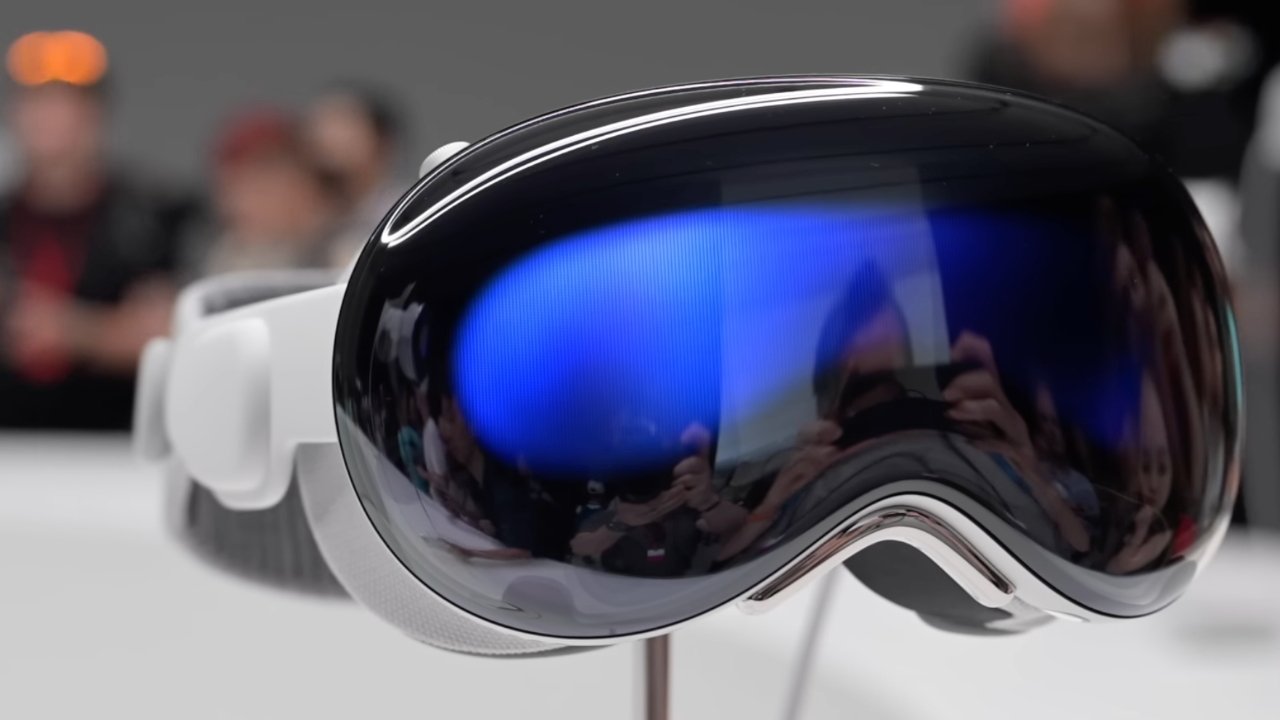
Vision Pro at Apple Park
Instead ofintroducing its Vision Pro headset by touting new games or fitness classes, it did so with a heavy dose of multitasking and emphasis on how we work.
It's definitely easier for the company to justify a $3,500 headset if the product can assist in people's work-related projects. Even if using it for Disney+ content and sporting events will be more intriguing.
But let's forget the price for a minute. During the product introduction, three of the 10 individual apps appearing on the "Home View" were very productivity driven: Notes, Freeform, and Keynote.
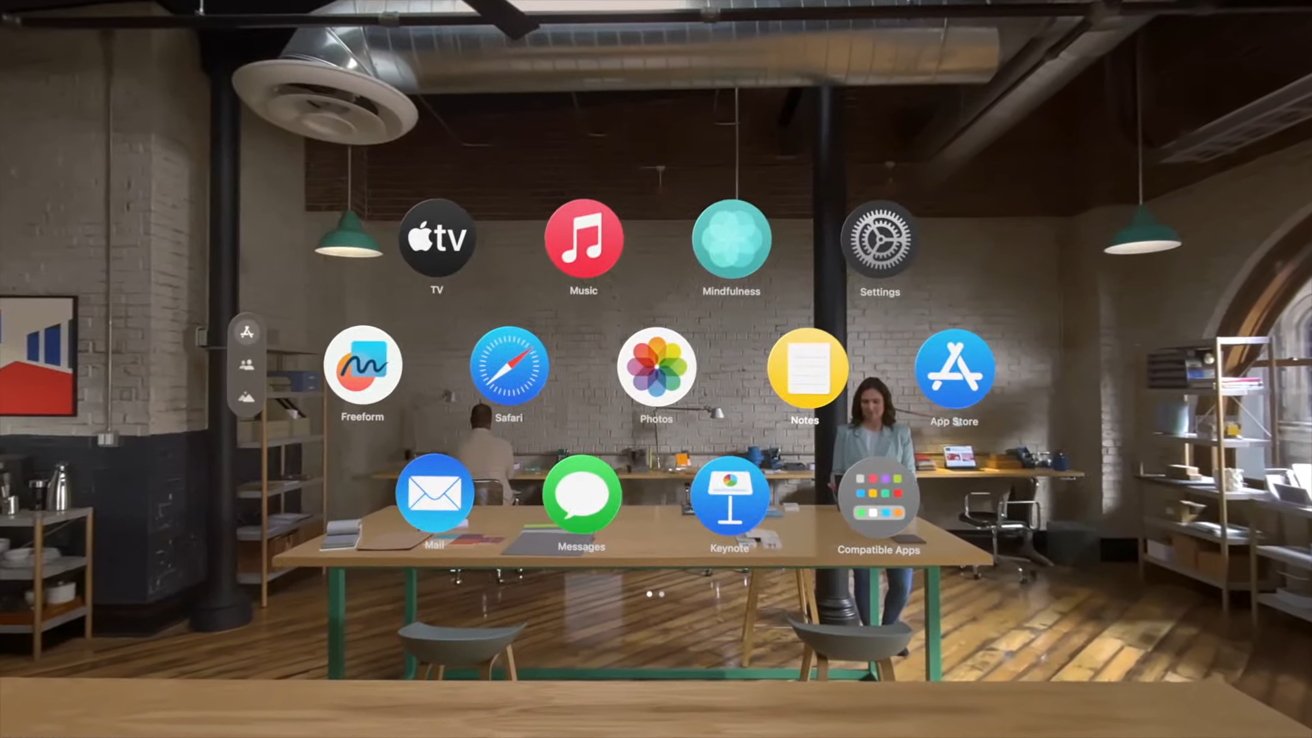
Home View
Arguably, the Mail app, Safari, and Messages could also be heavily used for work-related tasks. Leaving only Music, Mindfulness, Photos, and TV as the other first apps people saw when Vision Pro was shown to the world.
For better or worse, Apple decided to lead with the proportion of spatial computing as a new way to work. After hands-on demos of Vision Pro, nearly everyone has corroborated Apple's performance claims. If people are intrigued, rather than nauseated, by spatial computing, then it has a real chance to attract workers.
Let's look at how Apple's Reality Pro could alter the ways we work going forward by creating a new workspace paradigm and bringing people closer than ever. If it can do those things then the Vision Pro is certainly a logical next step in the way a lot of people work.
A new workspace
Apple's first argument for spatial computing work is an "infinite canvas." It's not only being able to have a big screen for your Mac, having gobs of windows, or even navigating them quickly, it's all of these things combined.
Using your entire surroundings to place apps could make ambitious people ultra-productive. Take on as many windows and virtual screens as your brain can handle.
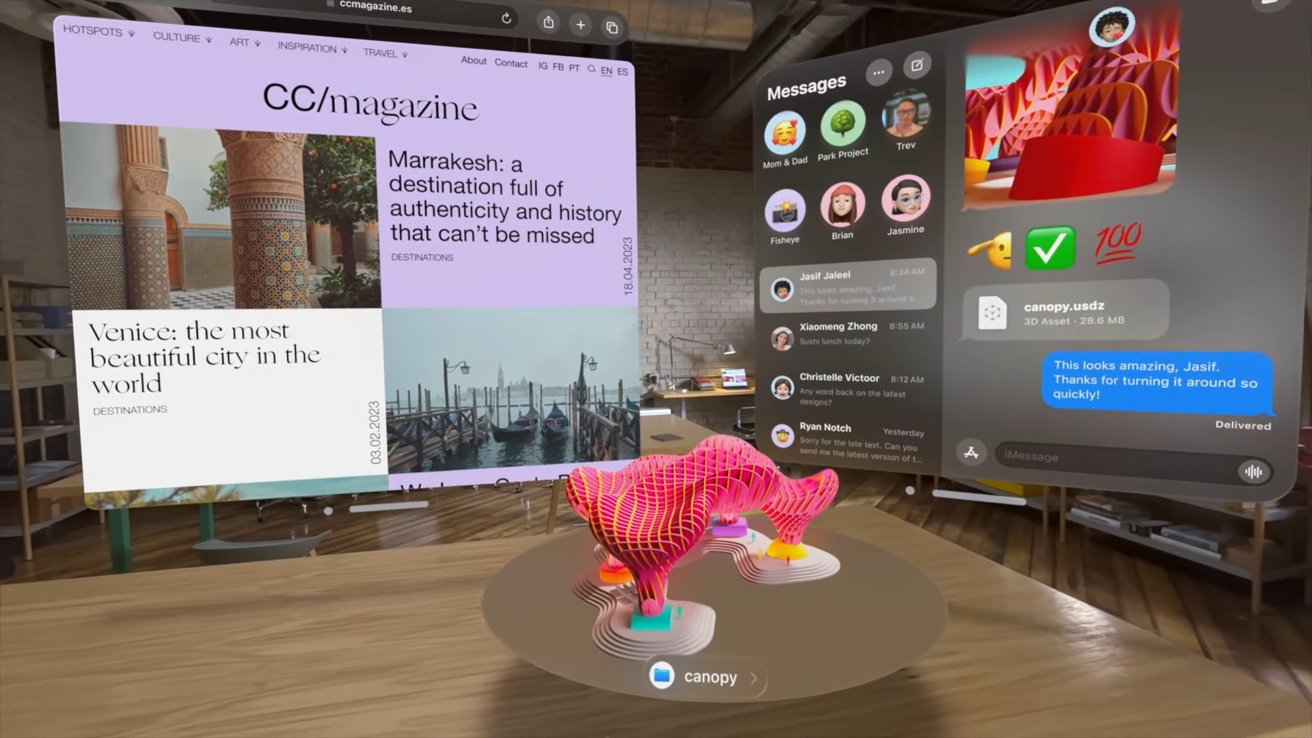
Inside Vision Pro
Instead of needing to bounce back and forth between Notes, Safari, Messages, and a presentation, you could have all of those things up at the same time, surrounding you.
To move back and forth, Apple imagines you'll only need to glance back and forth and utilize quick pinch gestures. Until brain implants come along, eye-tracking may be the fastest form of user input available.
While I can't speak to Vision Pro specifically yet, I have used remote desktop apps on a Meta Quest 2, and a computer screen with TCL's NXTWEAR S XR glasses.
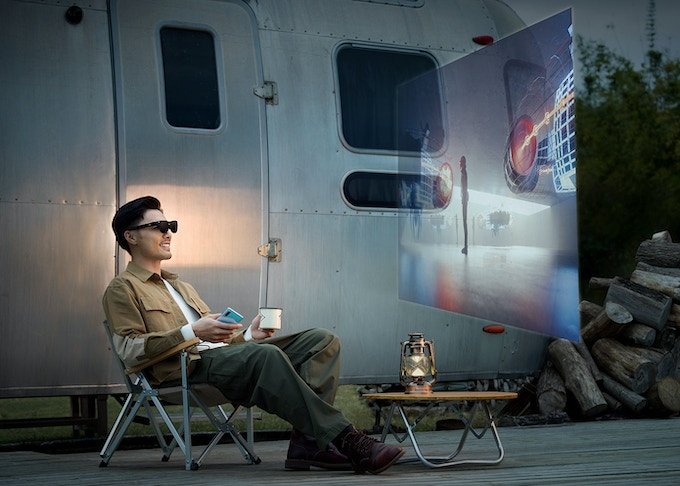 Viewing content on TCL NXTWEAR S XR glasses
Viewing content on TCL NXTWEAR S XR glasses
The personal view of work documents while on the couch or away from my desk was novel in those devices. Of course, there were clarity, comfort, and input issues with those products, but the infinite canvas idea wasn't one.
The Vision Pro headset looks like it could absolutely provide a private, vast canvas for dealing with several work projects at the same time.
After all, it would only take about two Studio Display monitors to get into the price range of Vision Pro -- or one Pro Display XDR to blow past the price.
Add in Apple's synced iCloud ecosystem from people's iPhones and support for Magic Keyboard and Magic Trackpad and you have a real productivity machine that adapts to your space.
Collaboration and connection
Not only did Apple highlight working with Vision Pro at the office, but it also pointed out that it thinks a spatial computing device will be good while traveling.
You can, of course, collaborate on a document on your Mac while sitting in a hotel room. But you can't necessarily do so in the same way as you would at home.
If you can replicate a muti-screen setup on Vision Pro, then your productivity doesn't need to change when working from different locations. Spatial computing looks to allow you to bring your whole desk and office with you, rather than only your computer.
Time will tell, but I do think people will be more willing to collaborate on the go and more freely if their entire workspace is available all the time. Virtual backgrounds are a thing because a lot of people don't want to share their environments.
Spatial computing keeps Vision Pro users connected to their environments without sharing that personal space with anyone they don't want to. It's a brilliant solution for slowing an increasingly intertwined home and work relationship people are finding themselves in with their jobs.
Even though it wasn't an app shown on the Home View, FaceTime, pun intended, is an obvious collaboration star. The true collaboration and connection star of Vision Pro behind FaceTime is SharePlay.
Apple's SharePlay technology has been around for years but it hasn't really gotten much of the spotlight or consumer attention. Up until now, watching a movie across two iPhones was a bit awkward and more of a demo.
However, SharePlay as the linking piece for documents, presentations, and all kinds of files you'd like to share during spatial computing is much more interesting.
It's no longer about casual one-to-one sharing. It's much more important for working group sessions and plugging content into the headset space. Additionally, because SharePlay and FaceTime are supported across iPhones, iPads, and Macs, it's a lifeline so a sole Vision Pro user can collaborate in a group full of mixed devices.
Work isn't the killer app, but it's a killer app
Apple highlighted plenty of uses for Vision Pro across a spectrum of content types, but it really focused on work and being productive. Frankly, spatial computing could end up making Macs less compelling before the iPad ever matures enough into that role.
Yes, Vision Pro is also coming for Meta and its Oculus headsets, eventually. But the other way spatial computing could find its niche in the workplace is by first wiping out Microsoft's HoloLens devices.
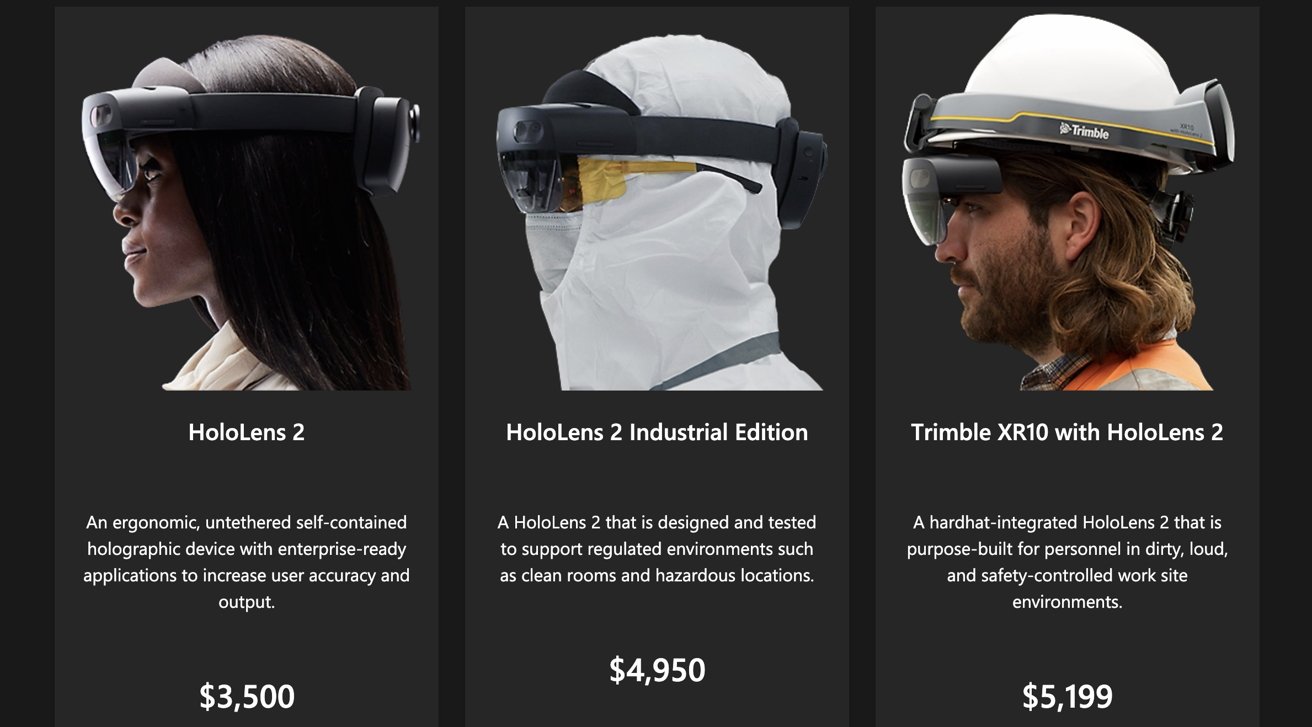
Current HoloLens models
The HoloLens 2 starts at exactly $3,500 and go up in price for industry-specific needs. I've had a chance to try the original HoloLens and it was interesting at the time but comically rudimentary compared to what Apple is showing off now.
The latest HoloLens might be dramatically better now, but based on how the company is marketing the product, it doesn't look overly impressive. There's no reason why certain industries couldn't replicate their work-related uses of HoloLens on Apple's hardware.
Most companies already have some familiarity with developing iOS apps. Plus, let's not forget that the iPhone ended up wrecking Blackberry and changing the corporate world of mobile phones just as much as it took over the consumer space.
With computing power, amazing input from early hands-on reports, and a thriving software development ecosystem it's hard to see how spatial computing with Vision Pro isn't the future of work, even if consumers are slow to adopt it.
Read on AppleInsider

Comments
The Vision Pro *will* be a productivity boon to those who travel, no doubt. There's simply no way to carry around multiple monitors on business trips. But the folks who travel the most (executives, sales, marketing) are not typically the folks who need multiple monitors.
So if 'infinite workspaces' aren't really that much of a productivity enhancer, what's left? Perhaps the eye-tracking + pinch is a split-second faster than the mouse move + click? Hard to justify $3500 for a few seconds saved per work day. What about all the other mouse/keyboard related actions people do every day - there are literally thousands in a modern GUI. They cannot all be replicated with simple eye tracking and hand gestures. Take the simple use case of copy/paste. Done a million times a day in a work environment: click on or drag on some text or file to select it, hit <ctrl-c> to put it in the clipboard, then click the mouse somewhere and hit <ctrl-v>. I don't think this can be done efficiently with eye tracking and gestures alone - e.g. how do you even use eye tracking to pick a word vs. a sentence vs. a paragraph? And if the user has to resort to using a keyboard, mouse, or Siri, by the time they've accomplished the task, a regular PC user will have done 10 of those operations.
The author says that the Vision Pro could help collaboration and gives some nebulous use case involving FaceTime and travel. But let's take a much more concrete use case: you're at the office and want to show your work to your coworkers. It's showing in a window in your workspace - but your colleagues can't see it. You can't all huddle around the monitor and share ideas. Sure, if everyone on your team has Vision Pro, you may be able to do so 'virtually', but it won't be nearly as seamless & spontaneous proposition as simply calling your coworkers over to come see/discuss.
The proof is in the pudding, as they say. I'd like to see one concrete work related use case in which a Vision Pro would blow away the standard computer + monitor(s) + keyboard + mouse. Not some hypothetical, future uses cases - that's not what businesses use when they decide whether to move their employees to new hardware.
Apple cycled through a lot of use cases to give a taste of everything the device can do.
I'd also argue that we've basically seen one WWDC keynote, so we really don't have any idea of how Apple is "marketing" the product.
Everyone knows where everyone wants to go. It's how they get there and at what cost that is more important.
Moving the screen towards you for a more immersive experience is the most basic goal. Interacting with a 3D like environment is part of that. Then the audio/visual experience itself (resolution/quality etc). The computer experience. Interaction with the external environment.
Size, battery life, 'speed' etc.
It's not exactly a new field.
But it is a new Apple ecosystem and there will be daily announcements from Apple developers in time highlighting the fact that they have ported their software over to Apple VisionOS, and that drumbeat Tsunami, will get louder and louder as we get closer to Apple’s Vision Pro release date. The R1 SOC is also new what are it’s full spec’s capabilities?.
The competition if there is any won’t have any of that over the next six months, a long slow steady drum beat of a rising army of VisionOS developers.
https://developer.apple.com/news/?id=h3qjwosp
Whether via SharePlay or other, making it easy to share documents, presentations or the desktop using FaceTime -- while a FaceTime call is in progress -- is the way to go. And of course, being able to do so would be valuable for all FaceTime users, not just users of spatial computing/AVP.
If there is something in the works, Apple wouldn't mention it till it is ready and if there is nothing in the works, they wouldn't want to create any speculations.
WWDC is a developers conference. This is a brand new platform, the promo was mainly directed at app developers and content creators to hopefully get them on board. I'd argue they spent more time driving the "Spatial Computing" paradigm than anything else.
Everyone is moving on the same roadmap and with the same end goals.
That industry roadmap was there years before Apple even announced the Vision Pro. Now Apple is officially on it.
None of us may be big Zuckerberg fans but what he said the other day wasn't really off the mark.
If you re-watch the presentation how much was truly 'new'? Or not already planned?
If anything, the true upshot was that it tempered people's expectations, which is no bad thing. Perhaps some people were simply getting ahead of themselves.
The R1 is a dedicated chip for specific tasks. Those kinds of specific chips are all over the place.
Here’s one for RF processing which could very well end up in an XR device at some point:
https://www.gizchina.com/2023/03/06/honor-c1-rf-chipset-launched-sets-a-new-benchmark/
If there are no general purpose chipsets up to a particular task then companies tend to bake their own. They might be for in-house use like those from Honor, Huawei, Google, Apple etc, or made available on the open market like those from Qualcomm, Broadcom, Mediatek, Sony etc.
You mention the full specs of the R1 but what are the full specs of the Vision Pro?
With most tech announcements, what is not said (or done) is just as important as what is said and done.
We know there is no cellular option but it was surprising, to me at least, that they kept most of the presentation in the AR realm and not so much the VR realm. No one knows how many of the announced features actually work because those who had hands on access were not allowed to use them.
Now, for a non-production unit that is the order of the day. Especially as those units would be running early software implementations but the reality is that no one got to try out some of the tentpole features.
Ecosystems are just ecosystems.
They serve a purpose and there is a lot to say on that subject but not really relevant here.
The Vision Pro will just slip into the Apple ecosystem. But then again, why wouldn't it?
How well? No one knows yet.
It is true that developers are an important component of many ecosystems and of course the Vision Pro was announced now precisely to be able to widen and hone the developer support. Marketing was another factor. That was absolutely necessary.
My take is that the package as a whole looks great. The finesse. It all comes at a price but that has to be understood. Let those with the disposable income and the will to be early adopters iron out the wrinkles.
The roadmap, though. There's not much new there.
Meanwhile, Apple, again, "stuns" competition with custom R1 sensor processor, on top of the M2 processor.
Competitors: "Everything is nominal", "Look at our user base and marketshare", "Look at our affordable prices", "Look at our roadmap", "Ecosystems are just ecosystems"; state Apple is doing nothing that they haven't already explored, all while they quietly watch any future profits shrink to nothing.
Why did Honor even develop the chip if slight gains were the order of the day?
You have deliberately ignored the point which is actually worse than just missing it!
The point was that if you can't get the results you want with off-the-shelf solutions (even slightly modified ones) you bake your own.
It's what Honor did.
It's what Apple did.
It's what Huawei did.
It's what lots of companies do!
Absolutely nothing out of the ordinary.
Right?
It is very much out of the ordinary.
* Google Cardboard a slight exception, though it was so much less ambitious that it barely counts.
** HoloLens was always targetted for specialist productivity, not for mass appeal.
Eyetrackers are very 'old' technology and have been up for inclusion on headsets for a while. They are simply more expensive to implement actively (as opposed to passively which is available on some consumer VR headsets) because, once you remove the controllers, you need to add another way (gestures for example) to resolve the same problems.
That isn't technology related per se. It's more of a cost consideration. I've been working in UX for a few years now and eye trackers are essential.
As mentioned above, gesture recognition is another area brought on through the absence of controllers but again, gesture interaction brings cost considerations. Gesture recognition is also a well worn technology.
If you reduce the importance of cost in your consumer focused product, the door opens to other options. That is what Apple has chosen to do with the initial release although I'm sure an 'SE' version is being planned, and IMO sans the bells and whistles.
Zuckerberg and many other companies have spoken about these aspects for some time. There have been lots of concept devices, prototypes and whatnot. The problem is price and mass consumer appeal for a device that will not get anywhere the usage time of a phone.
We have known where everyone wants to go for a very long while and it's the same place Apple wants to go.
I believe Xiaomi announced something at MWC and even used the word 'spatial' in computing terms. Quite logical when you consider that VR is spatial by definition.
The reason active eye tracking is not commonplace in VR headsets is simply because controllers are cheap and extremely functional.
Per avon b7 in another forum;
Yeah, good to know; controllers are cheap and functional, excepting they can be a pain, and sometimes the controllers can lose sync withe the unit, which is an even bigger pain.
Great salesmanship on that! You convinced me that the Vision Pro will be not only better, but more reliable.
Yes. Batteries can be a pain.
Yes. Controllers are cheap and functional.
The price difference will more than make up for any inconvenience.
How did I convince you of anything?
No one has been allowed to use the gesture functionality of the Vision Pro. No one has the slightest idea of how it will work in the real world.
We have no idea how the system will handle false positives on gestures.
What I was looking for is a display with "infinite" size or infinite canvas. They are close with that with this 1st gen model. If there is a TB4 wired connection to a Mac, this would open up its market to basically all Mac users in being able to display everything the Mac can, spread across the entire range of the VP. What they presented was basically a Mac AirPlaying to VP, and they will be WiFi bandwidth limited, resulting in 1 Mac "display". This puts the onus on Apple and developers to port apps to VisionOS. Terminal.app, Xcode, the usual Mac apps have to be native VisionOS apps to take advantage of all the display space. Eg, I want to have 4 to 6 terminal windows, 10 to 20 pdf apps, office apps, all displayed in front of me. Just a wall of app views, interleaved, spread across 180° side to side and probably stacked at least 2 high. Like in the Matrix, but with virtual displays, not real ones. Assuming I don't puke from it.
If they can do that by the time they ship the VP, there's going to be people buying it and using it all day, let alone 2 hours. The problems then become the fundamental wearable issues, not technology GUI issues. Can a person wear it for 12 hours a day? Does a person sweat with it on? I'm thinking they need to a have special light seal and strap design to probably balance the headset so people can do that. If not, 3rd parties will probably offer it.